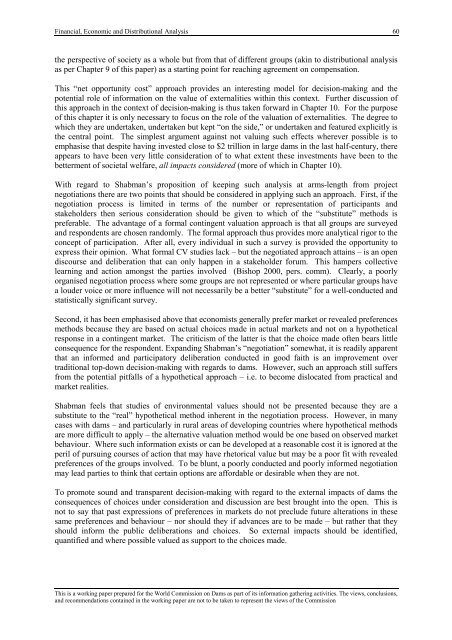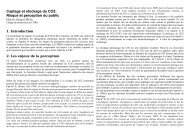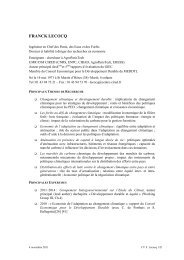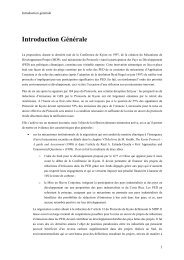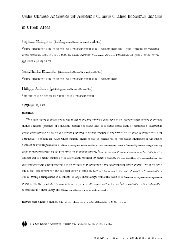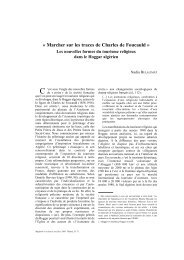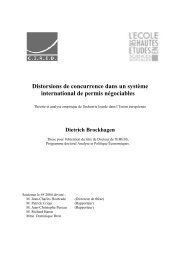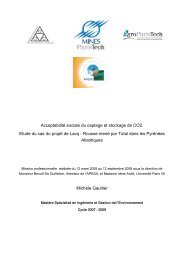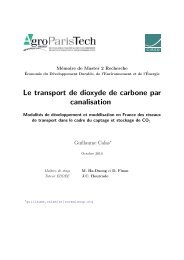Financial, Economic and Distributional Analysis - Centre ...
Financial, Economic and Distributional Analysis - Centre ...
Financial, Economic and Distributional Analysis - Centre ...
Create successful ePaper yourself
Turn your PDF publications into a flip-book with our unique Google optimized e-Paper software.
<strong>Financial</strong>, <strong>Economic</strong> <strong>and</strong> <strong>Distributional</strong> <strong>Analysis</strong> 60the perspective of society as a whole but from that of different groups (akin to distributional analysisas per Chapter 9 of this paper) as a starting point for reaching agreement on compensation.This “net opportunity cost” approach provides an interesting model for decision-making <strong>and</strong> thepotential role of information on the value of externalities within this context. Further discussion ofthis approach in the context of decision-making is thus taken forward in Chapter 10. For the purposeof this chapter it is only necessary to focus on the role of the valuation of externalities. The degree towhich they are undertaken, undertaken but kept “on the side,” or undertaken <strong>and</strong> featured explicitly isthe central point. The simplest argument against not valuing such effects wherever possible is toemphasise that despite having invested close to $2 trillion in large dams in the last half-century, thereappears to have been very little consideration of to what extent these investments have been to thebetterment of societal welfare, all impacts considered (more of which in Chapter 10).With regard to Shabman’s proposition of keeping such analysis at arms-length from projectnegotiations there are two points that should be considered in applying such an approach. First, if thenegotiation process is limited in terms of the number or representation of participants <strong>and</strong>stakeholders then serious consideration should be given to which of the “substitute” methods ispreferable. The advantage of a formal contingent valuation approach is that all groups are surveyed<strong>and</strong> respondents are chosen r<strong>and</strong>omly. The formal approach thus provides more analytical rigor to theconcept of participation. After all, every individual in such a survey is provided the opportunity toexpress their opinion. What formal CV studies lack – but the negotiated approach attains – is an opendiscourse <strong>and</strong> deliberation that can only happen in a stakeholder forum. This hampers collectivelearning <strong>and</strong> action amongst the parties involved (Bishop 2000, pers. comm). Clearly, a poorlyorganised negotiation process where some groups are not represented or where particular groups havea louder voice or more influence will not necessarily be a better “substitute” for a well-conducted <strong>and</strong>statistically significant survey.Second, it has been emphasised above that economists generally prefer market or revealed preferencesmethods because they are based on actual choices made in actual markets <strong>and</strong> not on a hypotheticalresponse in a contingent market. The criticism of the latter is that the choice made often bears littleconsequence for the respondent. Exp<strong>and</strong>ing Shabman’s “negotiation” somewhat, it is readily apparentthat an informed <strong>and</strong> participatory deliberation conducted in good faith is an improvement overtraditional top-down decision-making with regards to dams. However, such an approach still suffersfrom the potential pitfalls of a hypothetical approach – i.e. to become dislocated from practical <strong>and</strong>market realities.Shabman feels that studies of environmental values should not be presented because they are asubstitute to the “real” hypothetical method inherent in the negotiation process. However, in manycases with dams – <strong>and</strong> particularly in rural areas of developing countries where hypothetical methodsare more difficult to apply – the alternative valuation method would be one based on observed marketbehaviour. Where such information exists or can be developed at a reasonable cost it is ignored at theperil of pursuing courses of action that may have rhetorical value but may be a poor fit with revealedpreferences of the groups involved. To be blunt, a poorly conducted <strong>and</strong> poorly informed negotiationmay lead parties to think that certain options are affordable or desirable when they are not.To promote sound <strong>and</strong> transparent decision-making with regard to the external impacts of dams theconsequences of choices under consideration <strong>and</strong> discussion are best brought into the open. This isnot to say that past expressions of preferences in markets do not preclude future alterations in thesesame preferences <strong>and</strong> behaviour – nor should they if advances are to be made – but rather that theyshould inform the public deliberations <strong>and</strong> choices. So external impacts should be identified,quantified <strong>and</strong> where possible valued as support to the choices made.This is a working paper prepared for the World Commission on Dams as part of its information gathering activities. The views, conclusions,<strong>and</strong> recommendations contained in the working paper are not to be taken to represent the views of the Commission


